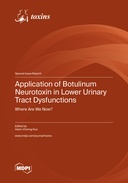Explore

Application of Botulinum Neurotoxin in Lower Urinary Tract Dysfunctions: Where Are We Now?
0 Ungluers have
Faved this Work
Login to Fave
Evidence has shown that botulinum toxin A has advantages in lower urinary tract dysfunctions (LUTDs), especially in interstitial cystitis, urethral sphincter dysfunction, and inflammatory bladder disorders which currently cannot be adequately treated with oral pharmacological medications. This Special Issue has collected original or review articles that focus on the novel applications of botulinum toxin A in LUTDs. The research has been updated and contains novel therapeutic applications of botulinum toxin for bladder or urethral dysfunctions. This Special Issue of Toxins provides current knowledge surrounding the status of botulinum toxin in functional urology and LUTDs.
This book is included in DOAB.
Why read this book? Have your say.
You must be logged in to comment.
Rights Information
Are you the author or publisher of this work? If so, you can claim it as yours by registering as an Unglue.it rights holder.Downloads
This work has been downloaded 56 times via unglue.it ebook links.
- 56 - pdf (CC BY) at Unglue.it.
Keywords
- adverse events
- Aged
- bladder inflammation
- bladder oversensitivity
- bladder pain syndrome
- bladder pain syndrome/interstitial cystitis
- botox
- botulinum toxin
- botulinum toxin A
- botulinum toxin A injection
- botulinum toxins
- detrusor overactivity
- detrusor underactivity
- dysfunctional voiding
- dyssynergia
- Incontinence
- interstitial cystitis
- interstitial cystitis/bladder pain syndrome
- intravesical injection
- Liposome
- long-term treatment
- lower urinary tract symptoms
- lower-urinary-tract dysfunction
- medicine
- Men
- n/a
- neurogenic bladder
- onabotulinum toxin A
- onabotulinumtoxinA
- overactive
- overactive bladder
- parkinson’s disease
- platelet-rich plasma
- poor relaxation of the external sphincter
- postoperative complications
- Sapylin
- spinal cord injury
- Stroke
- therapeutic efficacy
- type A
- urethral
- urethral sphincter dysfunction
- urinary bladder
- urinary incontinence
- urine biomarkers
- voiding dysfunction
Links
DOI: 10.3390/books978-3-0365-7939-9Editions

